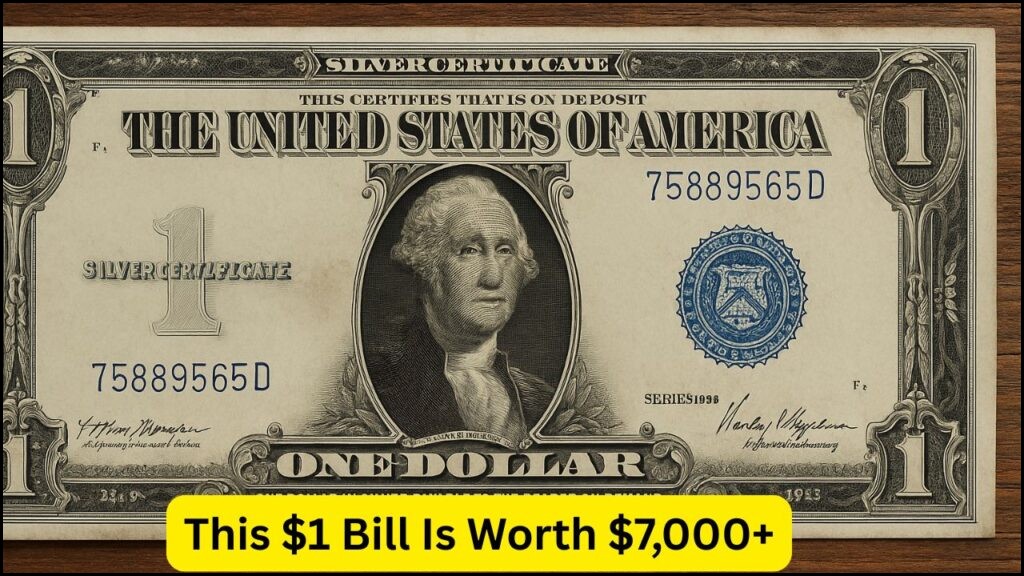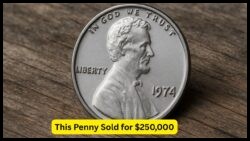Rare $1 Blue Seal Silver Certificate Note – For collectors of U.S. currency, few items hold as much historical charm and monetary intrigue as the $1 Blue Seal Silver Certificate. These notes, once common in the pockets of everyday Americans, have now become highly prized collector’s items, especially rare versions that can fetch upwards of $7,000 at auction. Whether inherited, found in an old wallet, or tucked away in a drawer, owning a Blue Seal Silver Certificate could mean more than just sentimental value—it could be a small fortune. Issued by the U.S. government during a time when paper currency was directly backed by silver reserves, these certificates are not only a symbol of the country’s economic history but also a gateway to numismatic treasure hunting. The key to their value lies in their series year, condition, serial number, and printing anomalies—factors that can significantly elevate a note’s price from a few dollars to several thousand.
What Is a $1 Blue Seal Silver Certificate?
Blue Seal Silver Certificates were introduced in the late 19th century and continued until the mid-20th century. They are distinguishable by their bright blue Treasury seal and serial numbers, setting them apart from modern green-seal Federal Reserve Notes.
Key Features of the Note:
- Blue Treasury Seal on the right side
- Blue Serial Numbers
- Phrase “Silver Certificate” printed across the top
- Statement “One Dollar in Silver Payable to the Bearer on Demand”
- Portrait of George Washington
- Series years ranging from 1923 to 1957
Why Some Are Worth Over $7,000
While many Silver Certificates are worth only $2 to $15 in circulated condition, certain rare types have become high-value collectibles.
Factors That Increase Value:
| Factor | Impact on Value |
|---|---|
| Year of Issue | Older years like 1923 and 1934 are more valuable |
| Star Notes (★) | Indicates replacement note; rarer |
| Low Serial Numbers | Serial numbers starting with 0000… |
| Printing Errors | Misaligned ink, doubled seals, etc. |
| Uncirculated Condition | Notes in pristine shape command premiums |
| Mule Notes | Mismatched plate numbers on front/back |
| Signatures | Some combinations are rarer than others |
| Plate Position Errors | Misprinted plate positions increase demand |
Most Valuable Series of $1 Blue Seal Notes
There are a few series that consistently stand out among collectors due to their rarity or historical context.
High-Value Series to Watch:
| Series Year | Estimated Value (Uncirculated) | Notable Traits |
|---|---|---|
| 1923 | Up to $3,000 | Large-size note with horse blanket design |
| 1934 ★ | $1,200 – $7,000 | Star notes especially rare |
| 1935A R/N | $600 – $4,500 | R and N experimental notes |
| 1935E | $350 – $2,500 | Low print numbers, clean condition |
| 1957 ★ | $200 – $1,800 | Star notes in GEM condition |
How to Check If Your Note Is Valuable
If you’ve found an old $1 Blue Seal Silver Certificate, use the following checklist to estimate its potential worth.
Step-by-Step Valuation Guide:
- Check the Series Year (front bottom-right corner)
- Inspect for Star Symbol (★) before serial number
- Examine Serial Number – Repeating, low, or radar patterns are rare
- Look for Errors – Ink shifts, misprints, or off-center prints
- Assess Condition – Folds, stains, or tears lower value
- Look at Signatures – Identify rare combinations
- Verify Plate Numbers – Mule note mismatches are rare
Tips for Selling Your Silver Certificate
Selling a high-value Silver Certificate should be done through the right channels to maximize profit and protect against scams.
Where and How to Sell:
- Auction Houses – Heritage Auctions, Stack’s Bowers
- Coin and Currency Shows – Direct collector exposure
- Online Marketplaces – eBay, but be cautious of scams
- Certified Dealers – Look for dealers with PCGS or PMG affiliations
- Grading Services – Get it graded by PMG or PCGS for credibility
| Selling Channel | Best For | Risk Level |
|---|---|---|
| Auction House | Rare notes, competitive bidding | Low |
| eBay | Common notes, fast listing | Medium |
| Coin Shows | Face-to-face deals with collectors | Low |
| Local Dealers | Quick cash, trusted evaluation | Low-Medium |
| Grading Services | Building long-term value | Very Low |
Recent Auction Sales and Market Trends
The demand for vintage currency has spiked in recent years, especially for U.S. silver certificates. Notes with historical relevance and preserved quality continue to set record prices.
Notable Auction Sales:
- 1935A R/N Experimental Note: Sold for $5,400 in 2022 (PMG 67)
- 1923 Horse Blanket Note: Fetched $3,100 in 2023 (Uncirculated)
- 1934 Star Note: Went for $6,950 in 2024 (Serial ★00000055A)
Owning a $1 Blue Seal Silver Certificate is like holding a piece of American monetary history. While many may not realize their worth, certain rare notes can surprise owners with windfalls of thousands of dollars. If you stumble upon one, don’t overlook it—examine it carefully, and consider professional appraisal if it meets any rare characteristics. What may appear as “just an old dollar” could in fact be a collector’s treasure worth more than $7,000.
FAQs
Q1. What is a Blue Seal Silver Certificate?
A: It’s a $1 note once redeemable for silver, with a blue Treasury seal and serial numbers.
Q2. How can I tell if my note is valuable?
A: Look for series year, star notes, errors, and overall condition.
Q3. Are all $1 Silver Certificates rare?
A: No. Common circulated notes are worth $2–$15, but rare ones can reach thousands.
Q4. Where can I sell a valuable note?
A: Try auction houses, currency shows, or certified dealers for best value.
Q5. What is a “star note”?
A: A replacement note printed with a ★ symbol—often rarer and more valuable.






